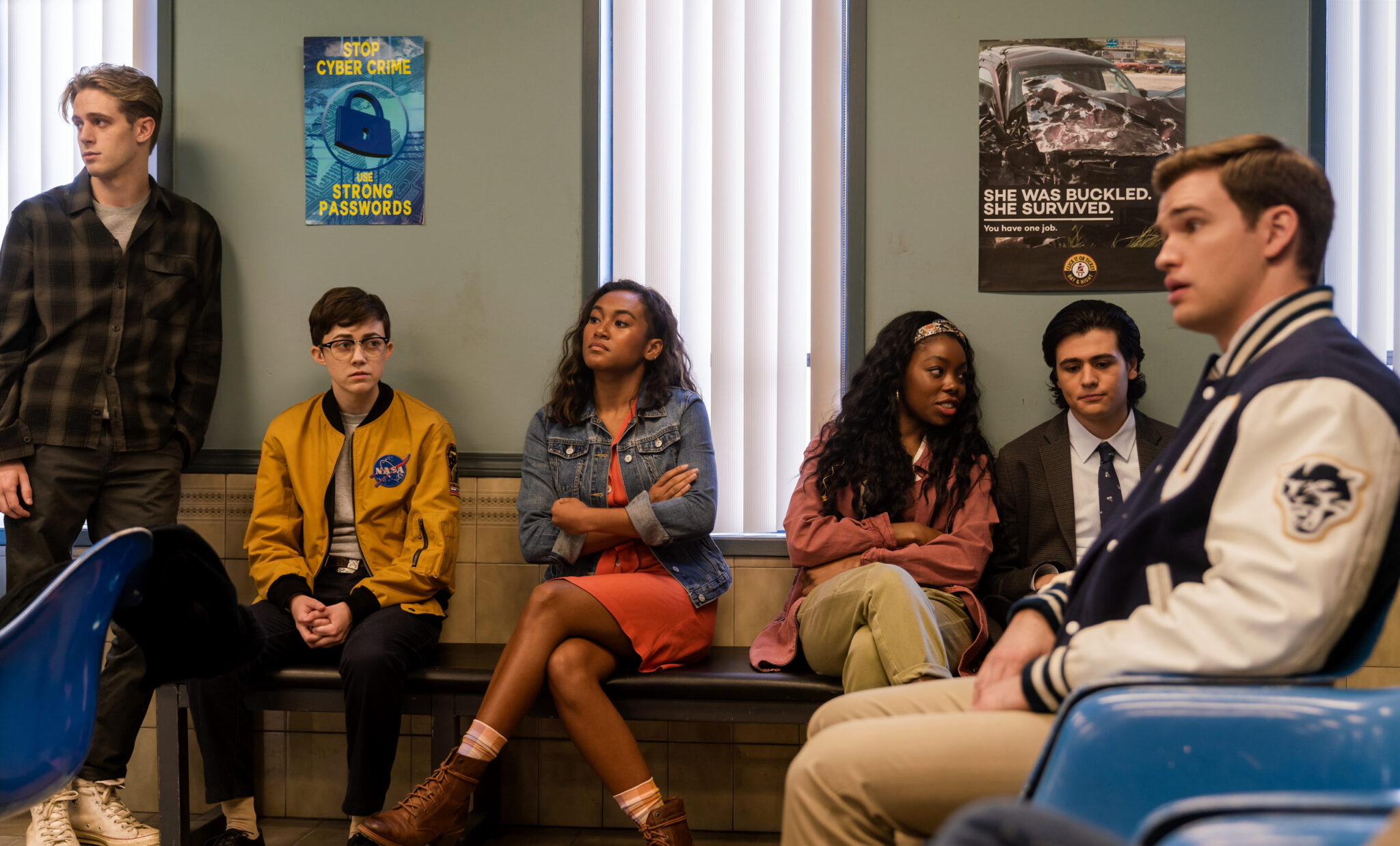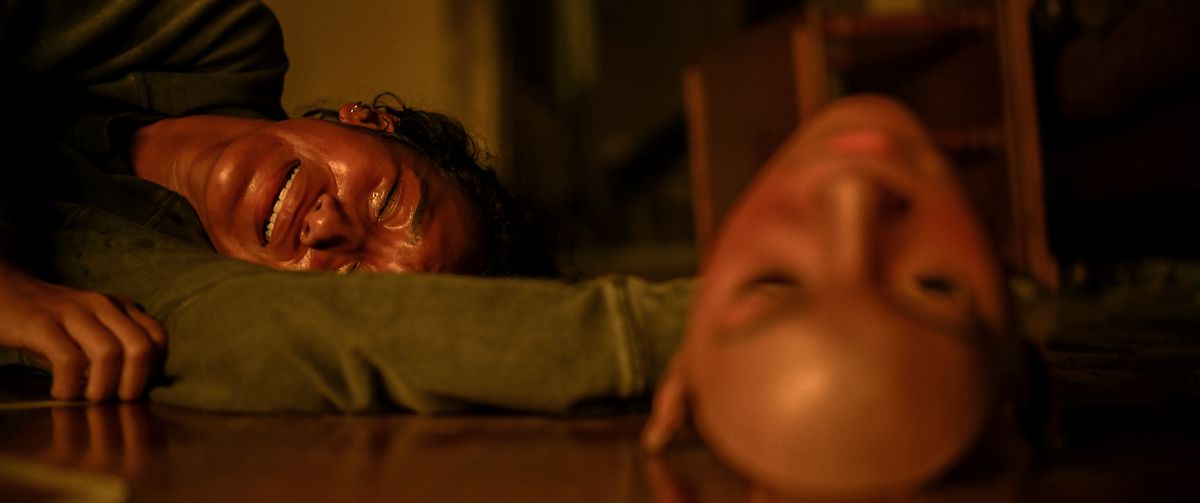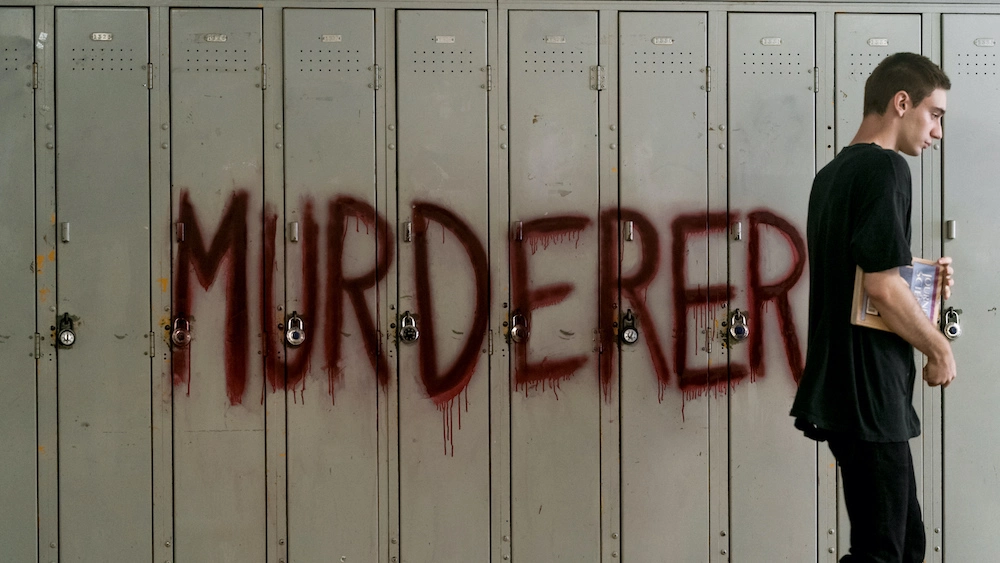Slasher films often take great joy in killing off horny stupid teenagers. In many ways, the genre is an example of America reveling in sex, drugs, and other taboos balanced with a hyper-puritanical sense of justice. The more interesting slasher films, like There’s Someone Inside Your House, seek to explore this rather than exploit it.
Patrick Brice’s There’s Someone Inside Your House is a teen slasher flick based on a Young Adult novel by Stephanie Perkins that does just that. Adapted for the screen by Henry Gayden, he understands how teenagers behave and talk in a way that so few movies, slashers included, actually do. Brice and Gayden capture the hum-drum of small-town life and the horrors of the powerlessness of being a teenager.
Like most modern horror films, There’s Someone Inside Your House has seen other horror movies. Unlike such genre classics as Scream, however, it’s less interested in meta text and more interested in its characters. Gayden’s script examines how teens can be both judgemental and sympathetic.

He shows that there are still outsiders, even in a post-Glee world. High schools may not be as clique-ish as when I grew up, but there will always be the ostracized and loner misfits, especially in a small farming town like Osborne, Nebraska. The characters are a motley group of outsiders. There’s Makani (Sydney Park), a Hawaiian transfer student who’s hiding a dark secret from her past; Alex (Asjha Cooper), a Black girl who takes pride in the descriptor “bitch-in-residence”; Darby (Jesse LaTourette) a white, non-binary-science-nerd; Rodrigo (Diego Josef) the secret drug addled Latino, and the son of the local land baron and resident rich white kid, Zach (Dale Whibley).
They sit at the lunch table snidely mocking the popular kids while also struggling to figure out how to grieve the latest victim who actively made their life a living hell. There’s Someone Inside Your House looks at the conflicts of not wanting your classmates to die but also not being all that broken up about it. The masked killer, a silent black-robed figure who wears a 3-d printed mask of his victim, seems hellbent on exposing secrets before offing his prey.
The first victim was a local football star and jock with a chiseled jaw, Jackson (Markian Tarasuik), who punched his gay teammate’s face repeatedly as part of a “hazing” ritual. In other words, he’s a gay basher. The second victim is the prim and proper church-going student council president Katie (Sarah Dugdale). Her last name is Koons, though after learning she posted an anonymous white nationalist podcast, we’re left wondering if her middle name didn’t also start with a “k.”
Brice and Gayden make the first two kills brutal and violent; for once, we somewhat enjoy the deaths. Jackson and Kate’s pleas of “that’s not me” or “it was meant as a satire” ring hollow as they confront their duplicitous duality, the face they show their friends, and who they are inside. The nature of secrets and past sins hang over There’s Someone Inside Your House like a cloud.
Makani, in particular, hides a tortured secret from her past. A secret that makes her a prime target for the killer. Something she knows all too well. She keeps it so close to her chest that not even her secret on-again-off-again-boyfriend, Ollie (Theodore Pellerin), knows what bothers her.
Ollie is the outcast of outcasts, the loner whose brother is the police chief and whose job is in danger because Zach’s dad, played by David Lewis, wants to replace the Osborne PD with a private security force. The killings aren’t helping the police department’s case, and Mr. Case looks delighted. Or he would if Zack wasn’t such a rebellious teen.
As a slasher film, There’s Someone Inside Your House does a remarkable job of showing teenagers as teenagers. One instance has Zack throwing a “secrets party” at his palatial estate, so everyone can reveal their secrets and thwart the killer’s masterplan. A party where he reveals his father has one of the country’s largest collections of nazi memorabilia.
Zack reveals he has been painstakingly taking every piece of his father’s collection and converting them into bongs. A group of teenagers having a party in defiance of a masked murderer killing off their friends and thinking using nazi paraphernalia as a bong is a form of protest captures how teenage rebellion can sometimes be shallow but often stems from a deep sense of uncertainty and fear.

I appreciated Brice and Gayden’s depiction of the hot and cold relationship between Makani and Ollie. This couple “gets” each other but not in any real, meaningful way. They don’t even know each other’s secrets; their bond coming from how the other makes them feel safe, their intimacy growing from how they feel uncomfortable almost anywhere else but with each other. So many movies give us couples meant to live happily ever after; it’s refreshing to see a couple that probably won’t make it past graduation, but that’s okay; not every relationship needs to light the world on fire.
There’s Someone Inside Your House, far from satirizing “cancel culture” or “callout culture,” instead shows how not all sins are equal. Yes, the first two deaths are a homophobe and a white supremacist, but they flip the script by having the third victim be largely innocent. Likewise, Brice and Gayden show the danger in conflating all transgressions as equally injurious and damaging. The perfect example is Makani’s secret, something she deeply regrets and will likely be haunted by in many ways, but which is not entirely her fault.
Park comes off so natural that it’s impossible to catch her acting, which in a teen slasher flick, is saying something. Her Makani is a teenage girl haunted by her past and wrestling with how much responsibility she should take. Even more, she’s struggling to forgive herself, which is often the hardest thing to do.
Brice can get fleshed-out performances from actors who embody their characters so well that they feel lived in despite being underwritten. Characters like Darby and Caleb are tertiary characters with little to no defining characteristics other than their otherness. Brice and his actors accomplish all this without sanitizing the characters or sanding off their rough edges, which is all the more remarkable.
Underneath the savage kills, There’s Someone Inside Your House has a big heart that understands that teenagers should be allowed to mess up and that not every mistake should define you. Still, the puritanical moralism of our ancestors runs hot through our veins, but we must be careful not to allow actual transgressions to pass without comment.
It’s a dicey and complicated idea shown in how Caleb (Burkley Duffield), the gay football player Jackson beat, isn’t as angry as his newfound friends. The football team and his former friends from the popular clique suspect he is the killer because he pities them. When he defends them with “They’re not the worst,” his friends remind him that they’re the worst to him. “Confused, okay. There’s a difference.” It’s that confusion that There’s Someone Inside Your House captures so well with its prickly characters.
I have to give Brice and Grayden credit for making There’s Someone Inside Your House one of the few movies to understand the term “virtue signaling.” And they show it without ever calling it that. A sign of restraint that most films fail to muster.
Brice presents the story with a kind of clear-eyed compassion while also indulging in the genre’s tropes. The brutal slayings, especially Katie’s death inside the church while her hate-filled podcast plays over her screams, are a fantastic bit of schadenfreude for the audience. But then he contrasts this with the next kill in which we desperately want the victim to escape and feel sad at his death.
Jeff Cutter’s visuals are slick and polished. Cutter and Brice have fun ratcheting up the tension while still finding time to meet the audience’s expectations. But more than anything, Cutter’s camera has a way of making the violence visceral. He and Brice accomplish this by always ensuring the character is seen as human, even when their “secret” is their inhumanity. Yes, cutting someone’s Achilles heel will always make me squirm. But something was haunting in how Cutter frames Katie in the confessional booth begging for her life.

The ending is a foregone conclusion if you have been paying attention. While the killer’s motives and logic don’t make much sense, it does make perfect sense in that rarefied contorted miasma known as white male brain logic. Plus, the killer’s monologue was top-tier privilege reverse-oppression mambo jumbo that I must applaud.
Yet, the most refreshing thing about There’s Someone Inside Your House is how Brice and Grayden don’t turn Park’s Makani into a “final girl.” Far from fighting off the masked killer alone, she and her friends fight the entity together. The group arrives at the burning corn maze where the killer is padding his body count and starts to help the survivors and confront the killer.
More than allowing its universe to be morally complex, There’s Someone Inside Your House continues the idea from 2019’s Black Christmas. Brice and Grayden are not satisfied with merely riffing on a genre or merely making a carbon copy with a diverse cast. They are, instead, dragging the genre forward into a new generation, much like the heroes of the film, refusing to let the past define them.
Images courtesy of Netflix
Have strong thoughts about this piece you need to share? Or maybe there’s something else on your mind you’re wanting to talk about with fellow Fandomentals? Head on over to our Community server to join in the conversation!

